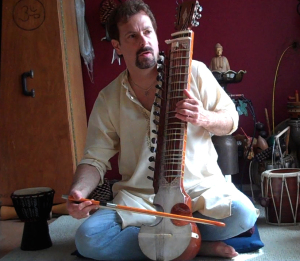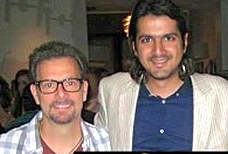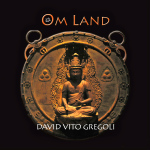 In the follow up to his multi-award nominated album Primordial Sonics, which I had the pleasure of writing about, guitarist/producer David Vito Gregoli, revisits the familiar landscape of world fusion music, but with a slightly different focus this time. On Om Land, Vito, as he is best known, delves deeply into one of the most primordial vibrations of all – the sound of Om. Stemming from ancient Eastern spirituality, Om is said to be without beginning or end, and embraces all there is. Finding a perfect collaborator in GRAMMY winning recording artist/producer Ricky Kej of India, along with singer Kimberly Haynes and percussionist/sound healer Christo Pellani, the album is a musical meditation on the divine sound.
In the follow up to his multi-award nominated album Primordial Sonics, which I had the pleasure of writing about, guitarist/producer David Vito Gregoli, revisits the familiar landscape of world fusion music, but with a slightly different focus this time. On Om Land, Vito, as he is best known, delves deeply into one of the most primordial vibrations of all – the sound of Om. Stemming from ancient Eastern spirituality, Om is said to be without beginning or end, and embraces all there is. Finding a perfect collaborator in GRAMMY winning recording artist/producer Ricky Kej of India, along with singer Kimberly Haynes and percussionist/sound healer Christo Pellani, the album is a musical meditation on the divine sound.
In my interview with Vito, he explained how the album came about: “Ricky Kej had told me he’d just finished an album in India called Om, and I was intrigued by the title. ‘Om’ has always resonated with me, as both the mantra and the yantra, and I’d always wanted to do an ‘Om’ project. He played it for me and I fell in love with the Indian vocals of Om on it. I asked him if he’d mind if I took those vocals and did something with them. He was enthusiastic about the idea. So I went to work on it and Ricky contributed both synthesizer and strings tracks and helped with the mix.”
Its certainly not surprising that Vito would be drawn to a project like this. He has been meditating since he was 13, doing yoga since the 80’s, and practicing Vipassana since 1992. When I asked Vito about the source of his inspiration, he replied: I’m inspired by my own spiritual journey and that’s reflected in the music I make whether it’s new age, classical, rock or whatever. It’s all a voice of my spirit and what I channel through it. I look at my self as a ‘sound painter.’ No matter what style I’m doing I’m painting with the colors of sound. Or to put it another way, especially in instrumental music, it’s like Michelangelo said, you are freeing the figure from the marble, not sculpting. The marble will tell you what it wants to be. The same way the music will.”
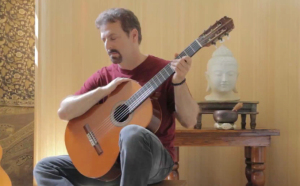 Although world fusion music has been Vito’s “thing” for quite a while, his musical beginnings were much less global. As he explains: “I saw the Monkees on TV and wanted to be Micky Dolenz so I got a little drum when I was 6. When I couldn’t get a full drum set, because we lived in an apartment, I eventually switched to guitar, as my next influence, the Beatles was heavy on. I did my first gig at 14 and haven’t stopped since.” He goes on to say: “I’ve always loved wide sweeping emotional music. Early Yes and Genesis had pseudo classical sections that I gravitated to which eventually led me to classical music and studying it, eventually getting a degree in guitar with a musicology emphasis.”
Although world fusion music has been Vito’s “thing” for quite a while, his musical beginnings were much less global. As he explains: “I saw the Monkees on TV and wanted to be Micky Dolenz so I got a little drum when I was 6. When I couldn’t get a full drum set, because we lived in an apartment, I eventually switched to guitar, as my next influence, the Beatles was heavy on. I did my first gig at 14 and haven’t stopped since.” He goes on to say: “I’ve always loved wide sweeping emotional music. Early Yes and Genesis had pseudo classical sections that I gravitated to which eventually led me to classical music and studying it, eventually getting a degree in guitar with a musicology emphasis.”
When I asked Vito about his connection to new age music, he replied: “I’ve always done ‘new age’ music. I just didn’t call it that then. I found an old cassette from 1976 and it was a very pre-Windham Hill-sounding piece. I had no idea anyone would be interested in this stuff. LOL.” And speaking of Windham Hill, artists such as Will Ackerman, Michael Hedges, Alex de Grassi, and Michael Manring were major influences on Vito.
On Om Land, according to the album notes, Vito has interwoven the human voice, synthesizers, percussion and acoustic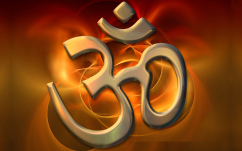 guitars to represent the spiritual and vibrational OM as a bath of sonic energy. The result is a soothing and yet uplifting listening experience that brings their audience into harmony with the Divine. He adds: “Just pronouncing the Om syllables creates a percussive vibration that flows from the back of the throat onto the lips. A-U-M. We started with that very personal and yet universal sound as the core, and then layered on our musical interpretations.”
guitars to represent the spiritual and vibrational OM as a bath of sonic energy. The result is a soothing and yet uplifting listening experience that brings their audience into harmony with the Divine. He adds: “Just pronouncing the Om syllables creates a percussive vibration that flows from the back of the throat onto the lips. A-U-M. We started with that very personal and yet universal sound as the core, and then layered on our musical interpretations.”
The album contains three extended tracks that are slightly over 20 minutes each. The first one is entitled “Saguna.” It begins, as do all of them, with the chanting of Om and deep Indian-style drone background. Over that is layered Vito’s nylon string acoustic guitar playing both Eastern and Western-influenced fills. It’s an interesting contrast, and not one that is commonly heard, but it is quite a nice combination. Another contrast here, and on the album in general, was a yin-yang balance between spaciousness and density. The background is densely layered with its chanting that ebbs and flows, the continuous drone sounds – both Eastern-style and sustained synthesizers, and bass notes. All of which add nicely to the deep mystical and meditative nature of the music. The spaciousness is in the guitar parts, which are more minimalistic and used sparingly in the mix. Vito is an excellent guitarist, and as someone who also plays sitar he has a good understanding of Eastern and Western music and scales. As the song evolves, percussion and synthesizer sounds are added.
By the time this first track ended, I was totally in the zone. At this point, I want to make clear that the music on Om Land is extremely meditative. It is created for going within and accessing deeper states of consciousness and inner peace. This is not made for entertainment as most music is – perhaps the word “entrainment” would be more appropriate. By nature, there is a consistency in the drone and background sounds that serve as a vehicle for meditation, yet within that, there are subtle changes and variations that come and go slowly as the piece unfolds. When one is in a deep contemplative state, the continuity of this kind of music is perfect to help maintain that flow. I also found that listening with headphones made for an even more immersive experience, and I highly recommend that.
According to Vito: “The second track, “Nirguna,” is more modal and based around a synth theme Ricky provided, and a variation I did on it with the Dobro and piano. Towards the latter part of the tune I brought in Kimberly Haynes singing an almost shamanic style vocal and in the piece’s climax I add the Bengali esraj, which is both plaintive and highly evocative.” Incidentally, an esraj is a stringed instrument that looks a little like a sitar but is played with a bow, like a cello, and has a haunting sound. An interesting addition is a bouncy electronic sequence that adds both motion and a contemporary feel. There is also another very occasional sound texture that I’m told was used to add a modern electronica vibe which I didn’t care for as much, but it’s a matter of taste. Perhaps I’m just old-school. However, all in all it’s a powerful piece and the female vocals add an ethereal air that is truly transcendental as they blend with the chanted Om vocals.
The third track, entitled “Pravana,” features Vito’s fingerstyle steel-string acoustic guitar as the solo instrument. He also plays bass, hand drums, piano, synths, and esraj on all the tracks. In addition to Vito’s drumming, Christo Pellani’s percussive ‘colors’ are heard thru out the album. While there is similar style to the three tracks, anchored by the Om chant, each one also has its unique characteristics that distinguish it. But, once again, this is music for meditation, and maintaining that space is its ultimate goal. I really liked the fact that when I started listening to a track, I knew there would be a continuous uninterrupted flow that would carry me through the piece without any sudden changes or shifts. And I did appreciate the subtle vocal and instrumental variations that drifted in and out creating musical interest, but not distracting from the meditative ambience. Another thing I liked about the album is that one can listen to it in its entirety or just tune into one track for a 20-minute spiritual recharge.
I see Om Land as a tool for introspection more than as something to listen to casually. While I greatly enjoyed the experience, I just had to make sure my feet were touching the ground after I got up from listening! Yet beyond the music itself, I have tremendous respect for artists like David Vito Gregoli and Ricky Kej, who use their artistry for the purpose of both inner peace and global peace. Their music is about uplifting and inspiring people, and in some small way, making this a better place. Om Land is a deep and powerful listening experience that can take one beyond their normal waking consciousness to an attunement with a primordial and universal vibration. And that’s certainly something we could use more of in today’s world.


